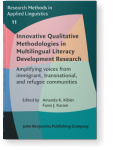Chapter 8
Families’ literacies of (in)visibilty
Methodological approaches to understanding precarity without
culpability
In our ethnographic research with mixed-status transborder
families who had relocated from the U.S. to parents’ hometowns in
México, we have sought to better understand what we term
transborder literacies of (in)visibility, or
diasporic people’s innovative interactions around texts that prepare
them to move across incompatible, racializing mononational
institutions divided by borders (Gallo & Adams Corral, 2023). In this chapter we
adopt a transborder literacies of (in)visibility framework to
trouble and unpack our research methodologies. We turn this lens to
our research practices to better understand instances where
transborder families’ actions challenged us as researchers to think
through the colonial roots of our own literacies and thinking.
Article outline
- Introduction
- Confronting colonial logics
- Extending reflexivity
- Overview of the study and its findings
- Beginning with a transborder lens
- Transborder literacies of (in)visibility
- Our research studies
- Methodological discussion: Rethinking theory for more equitable research
- Un-documenting transborder subalternity
- What we don’t write in our field notes
- Siempre hay una raíz
- Centering transborder knowledges, challenging colonial
logics
- Mis(sed) deliveries
- Navigating institutions and shifting (in)visibility
practices
- Implications for qualitative research on multilingual literacy
development
- Researcher literacies of subalternities
-
Notes
-
References
This content is being prepared for publication; it may be subject to changes.
